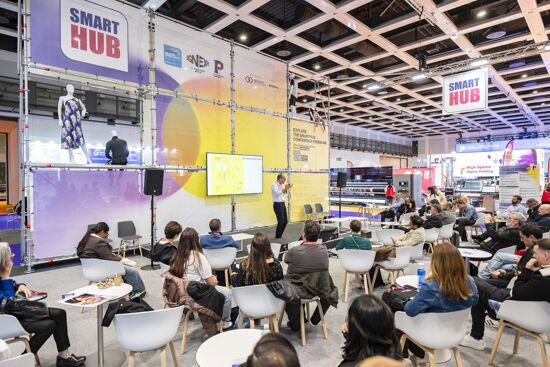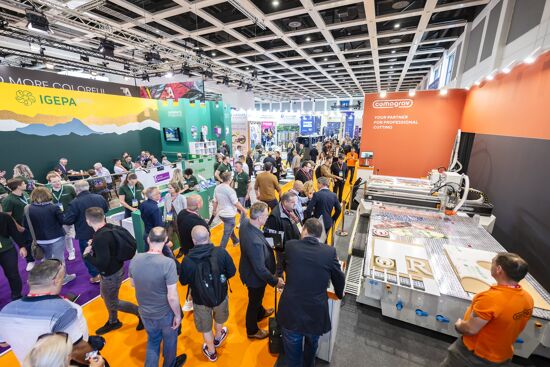The Market Shifts towards Pigment – New Developments and Market Trends for Décor and Apparel

As the pandemic draws to a close digital textile printing is continuing to carve an innovative path to the future of printed production. The growth of digital textile pigment printing is continuing apace - driven by its of ease of use, speed of production, cost efficiencies and sustainable attributes.
The pace of adoption towards digital pigment printing is accelerating and it is therefore not surprising to see the market make considerable investment in the production of pigment ink capacity. Kornit Digital’s multi-million-dollar investment in pigment ink manufacture was followed in March 2021 by Fujifilm’s announcement that it too was going to invest $20m in a new pigment ink manufacturing facility.
Pigment ink progress has been moving forward as well, with Farbenpunkte launching their Peractojet novel pigment ink in February 2021, while from Epson, also in February 2021, came the new range of Genesta PG-Revo pigment inks, and EFI Reggiani introduced their new Terra Digital Pigment ink in April 2021.
Similarly in the marketplace - Italian printer Creazioni Digitali who have been working with Epson’s Monnalisa pigment technology for a number of years expanded their pigment production with the further investment of a Kornit Presto. In America Spoonflower went for Durst technology alongside Kornit Digital’s pigment equipment, whilst in Poland Cottonbee having trusted their entire sales offer to Mimaki’s pigment printing know-how and equipment expanded their portfolio with the purchase of a Durst 190 printer for pigment production.
What was causing this drive towards pigment inks?
In a global printed textile market – analogue and digital - that is predicted to exceed $260 billion by 2025 (Grand View Research) - Pigment printing at 57% of the total - is the largest individual ink component, overshadowing any other ink type, whether Acid, Reactive, Disperse or Dye sublimation.
Yet in the digital textile printing market, estimated to pass $8 billion by 2025 (Allied Market research) pigment ink usage is estimated to be only 11% of the total ink types used for printing.
Historically pigment printing has been held back by printhead technology, however now, with the advent of high speed-high solids printheads such as the Epson PrecisionCore head, all this is changing - as ink technology and printhead technology move forward together to open up the unique advantages that pigment printing has to offer to the digital printer.

Aside from the ease, the speed and the sustainability advantages, digital pigment printing is unique in the way that it is able to print with high quality and fastness on fabrics that have mixed fibre composition. With Polyester-Cotton fabrics alone accounting for $57 billion by 2024 (Global Market Insights), and with a further $16 billion coming from other blends, such as Poly-Viscose, Poly-Linen, Nylon-Acetate and Cotton-Acrylic.
Therefore, pigment constitutes a huge opportunity of the printed fabric market that cannot be serviced by digital printing with either Reactive, Dyesub or Acid inks.
Further, it is true to say, that as digital textile print machines speed up, driven by innovation in technical application and printhead development, so the vast textile printing re-equipment market, estimated to reach $13.9 billion by 2025 (Allied Market Research) will be opened up to the availability of ever faster digital print machines as they evolve.
In 2021, in spite of the world still being affected by the pandemic, new printing machines, printing inks and print workflow software solutions have continued to be launched as manufacturers move the agenda forward in an accelerating market.
In the quest for speed of production, energy efficiency and the simplification of the print process - innovation towards a digital printing solution that removes the requirement for the pre-coating of fabrics for pigment printing has been paramount – “single-step” digital printing. All additional steps such as pre and post treatment can now be eliminated.

Digital textile printing innovations now deliver a sustainable manufacturing process with significant reductions in equipment, time, and manpower costs using pigment inks.
Advances in ink chemistry ensure that pigment technology delivers impressive printing results with excellent light fastness and wet rub fastness and can be used on all types of fabric, including blended fibres without pre-coating.
Machine platforms are now available from multiple vendors for light industrial and high- volume production and are designed specifically for all areas of the emerging digital textile printing marketplace. Industrial textile professionals, such as textile mills and web-to-print print houses can now choose from an impressive array of digital technologies to meet their production demands.
One-step processing can also be achieved by having the pre-coat unit in-line with the digital printer. Running before the printer the machine pre-coats the fabric prior to printing, allowing the printer to source their cloth, and coat it as they print in-house. Therefore, removing the need to hold coated stocks, which degrade over time.
This year there are in-line coating machinery offers from Setema of the Netherlands, GOTX from Pigment.inc, the Magnaroll from Zimmer of Austria, plus Swiftjet and Technijet from the UK.
All of this innovation and R&D has led to the availability of a myriad of new machinery options for the digital pigment printing sector in 2021. With inventive and ground-breaking offerings from Epson, Mimaki, EFI-Reggiani, Aleph, Zimmer, Kornit Digital, Durst and from Dgen as well as Colorjet - the market is expanding to meet demand as printers move to harness the simplicity and sustainability of digital textile pigment printing.
With digital pigment printing’s current technical progress, the horizon for the commercial fabric printer has expanded exponentially. Using pigment printing they can now print more or less any type of fabric to serve the Décor or Apparel marketplaces on demand - without being fearful of quality or fastness issues or the consistency of high-speed production.
Discover the latest innovations in digital textile printing at the Global Print Expo 2021, Europe's leading exhibition for screen and digital wide format print, textile printing and signage. Discover the latest products, network with like-minded individuals and explore new business opportunites. Register now and use promo code FESH101 to receive a discount of 30 euros.
Interested in joining our community?
Enquire today about joining your local FESPA Association or FESPA Direct
Recent news

Industry Experts Explore the Evolution of Smart Manufacturing in the Textile Industry
A FESPA SmartHUB roundtable at Personalisation Experience 2025 discussed smart manufacturing's transformative impact on the textile industry. Experts highlighted the shift to on-demand customisation, driven by digital printing, data analytics, and automation. Key takeaways included enhanced machine control, significant waste reduction through intelligent software and colour management, and improved sustainability via energy efficiency and near-shoring, ensuring agility and environmental responsibility in textile production.

FESPA 2025 gathers leading visionaries from across the speciality print industry in Berlin
FESPA Global Print Expo 2025, European Sign Expo and Personalisation Experience (6 – 9 May 2025, Messe Berlin, Germany) welcomed Visionaries from across the speciality print industry to shape the future of print, develop forward-thinking business strategies, and explore innovative ways to translate emerging industry trends into tangible growth opportunities.

Exploring Cutting-Edge Textile Printing Innovation with Adobe Print Engine 7
Adobe PDF Print Engine 7, launched at FESPA Global Print 2025, significantly advances textile printing. Debbie McKeegan shares how it automates non-white substrate management and RGB colour handling, expands colour gamuts with in-RIP multicolour transparency blending, and streamlines workflows for efficiency and sustainability. This update boosts customisation, reduces waste, and positions businesses at the forefront of digital print innovation.

FESPA Global Print Expo 2025 - Overall Highlights
FESPA Global Print Expo, Europe's leading print and signage exhibition returned to Messe Berlin from 6 - 9 May 2025.